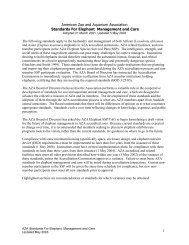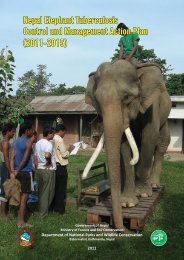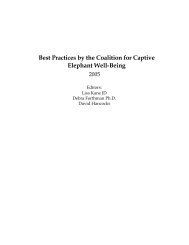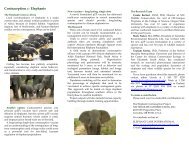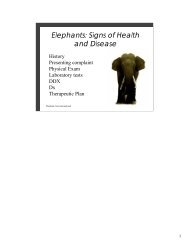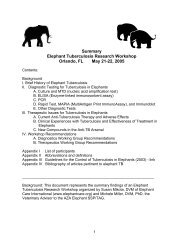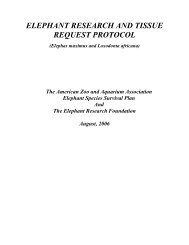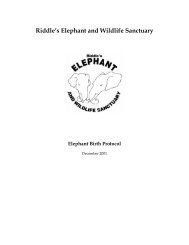Elephants Elephants - Wildpro - Twycross Zoo
Elephants Elephants - Wildpro - Twycross Zoo
Elephants Elephants - Wildpro - Twycross Zoo
- No tags were found...
Create successful ePaper yourself
Turn your PDF publications into a flip-book with our unique Google optimized e-Paper software.
B: FIELD DATA2.5 <strong>Zoo</strong>geography / EcologyPOPULATION, HABITAT AND DISTRIBUTIONElephasThe wild population of Asian elephants is now very fragmented (Fig.2.). Priorto habitat modification the range extended from the Tigris-Euphrates in thewest through Asia south of the Himalayas to Indochina and most of southernChina (Fig.2). The species is in grave danger and the surviving population ofbetween 30,000 and 51,000 is only a tenth of the population of Africanelephants. The important factors in Asia are reduction of habitat andpressures from man; about 20% of the world’s human population lives in thepresent range of the Asian elephant. A comprehensive survey of the Asianelephant was carried out in the 1970s (Olivier 1978). <strong>Elephants</strong> currentlyoccur in 13 countries, shown in Table III (WCMC and WWF International2001) (Santiapillai and Jackson 1990). <strong>Elephants</strong> require a large range and aretherefore one of the first species to suffer the consequences of habitatfragmentation. Populations continue to decline; from 1990 to 2001 numberhave decreased by more than 90% in Vietnam, near to 90% in Cambodia, bymore than 50% in Laos and 25% in Burma (Myanmar).All Asian elephants are forest animals, which require a shady environment,thus the conservation of forest is crucial to the conservation of elephants. Themajor population is in India, however the extensive forest, where elephantonce roamed widely, now cover less than 20% of the country and about half ofthat is suitable for elephants. A network of protected areas connected bycorridors has been proposed as a conservation strategy in India (Johnsinghand Williams 1999). Burma (Myanmar) has one of the largest remainingpopulations of Asian elephants in the world; about 50% of timber is stillextracted using elephants. These animals do not constitute a self-perpetuatingpopulation and so must be augmented by capturing wild animals. It ispossible that the current rate of capture may be above the maximumsustainable yield. In Sumatra resettlement of people from the overcrowdedislands of Java, Madura and Bali have created many new areas of elephanthumanconflict. This and logging of the commercially valuable timber speciesis increasing fragmentation of elephant habitat. In Vietnam the devastation offorest between 1961 and 1973 by bombs, napalm, herbicides and defoliantsconstituted a man-made eco-catastrophe. Since the war forests havecontinued to decline as a result of logging, shifting cultivation and fuel woodcollection. The Action Plan (Santiapillai and Jackson 1990) recommends acollaborative conservation programme with Vietnam, Laos and Cambodia.16




